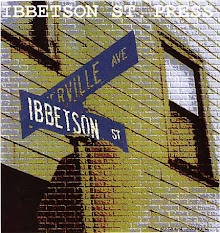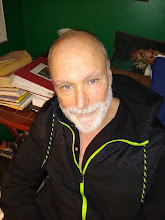Review of The INMAN REVIEW, Volume 1, Fall 2009, $4, Jahn Sood and Zachary Aiden Evans, editors, Cambridge Street Press, inmanreview@gmail.com
By Barbara Bialick
A new literary magazine in the hip nation of Cambridge has risen up to serve and explain the sensibility and heart of Inman Square. Published by Cambridge Street Press, it’s dedicated to bringing us short stories, poetry, arts and culture, perspectives, drawings and photography of the diverse people of Inman Square and environs. The interesting display ads from different businesses in the neighborhood further tether the review to the spirit of its neighborhood. Indeed, editor Jahn Sood, inspired by the works of Orwell, is also a barista at the 1369 Coffee House.
The new review is even blessed by former U.S. Poet Laureate Robert Pinsky, who writes, “This bouncy prose and poetry, these drawings and photographics are lively and soulful enough to be worthy of the name and the neighborhood…”
One is immediately introduced to its clever artwork, with a huge red and blue drawing of a human heart, where the streets of Inman Square are identified to be in the thick of veins and arteries, as drawn by Alethea Jones.
Here are some lines by some of the writers: “The human heart is a bare room…And there is also a window…” (Poem “Hot Power” by Ezra Furman)
“Man, amazing things always happen in books…Nothing interesting ever happens to me…” He then strings up white cats to balloons which are flying high in the sky.
(Cartoon “Love From Above” by Michael Pollock)
“Lather up with Cotton Mather…” (Poem “New England is an Acknowledgement” by Michael Sean Crawford)
“Boston loves close cropped/haircuts and baseball hats/just as poetry hates it…”
(Poem “Commemorative” by Patrick Duggan)
“Cigarettes. The awning looked like a haunted house, with all the smoke trapped under it. A guy named Bruce asked me if I was in a band…’ (Fiction “Peace” by Infamy Mills)
**********************************************************************************

Bankrupting Joe the Taxpayer by D.J. Golio (AuthorHouse)
Reviewed by Manson Solomon
What immediately springs to mind on first encountering this book is that old saw, you know, the one about never judging a book by its cover. But in this case, it is almost impossible not to. Indeed, it is clear that in this case we are actually expected to, that the cover is in fact specifically designed to hit us squarely between the eyes. The very title, Bankrupting Joe the Taxpayer, emblazoned across the top in bold red, is a call to judgment. Also on the aforementioned cover, below the title, there appear two stiffly posed cleancut college-age kids with their clean pockets turned inside out (see how empty they are) and blissfully untroubled countenances, whom we are implausibly supposed to take for embattled taxpayers.
Unfortunately, the judgment that this cover elicits is not the one the author intended. Rather than being moved to righteous indignation, we find ourselves compelled to ask instead just what is this book before us which would seek to draft off that signal halfwit responsible for such a coarsening of the 2008 campaign discourse? The plumber who wasn’t a plumber, who was in fact not even a Joe but a Samuel, and who turned out to be not an upstanding citizen but an unemployed and unemployable lumpish know-nothing tax delinquent.
The point of writing this book, the author tells us, is that “many people see an article on taxes and simply get turned off.” They want something comprehensible and engaging. You betcha! But somehow, page after page of ranting, for example, against the AMT (Alternative Minimum Tax, in case you wanted to know) is not exactly a page-turner for Jack and Jill the Readers. Sad to say, the contents do in fact do justice to the cover – the interior is as disingenuous as the exterior and evokes the same reverse response.
As one shovels one’s way through these turgid pages, one cannot help speculating that perhaps the kids posing on the cover might be a couple of the author’s students. For this book turns out to be, as far as I can tell, an attempt to turn the CPA author’s lecture materials for his course on taxation into a popular cash-register impulse buy. A not unreasonable aspiration which, unfortunately, it is not easy to pull off.
The author tries hard to instill popular relevance into the material by starting his pitch with photocopies of his phone bill. Not a bad idea. Everyone gets a phone bill, right? (Except perhaps the kids on the cover, whose parents presumably pick up the tab.) And everyone feels overcharged, right? So you poor aggrieved billpayers know very well what I am talking about, right? And ditto for the other utility bills reproduced in subsequent pages. However, that we get the author’s point doesn’t necessarily make for entertaining reading. To have a hope of grabbing us, the writing itself has to be entertaining, and entertaining writing is not what CPAs are generally known for. So -- here comes another old saw -- let the cobbler stick to his last. Just as it is probably not a good idea for a poet to prepare his or her own taxes, so it is probably inadvisable for tax accountants to attempt literature unaided. Like athletes and politicians, non-writers who turn to producing books should at least have the benefit of a professional ghost writer to craft and enhance the product.
So, as you may surmise, I did not find myself being entertained as I plowed the furrows of this opus, slogging through the turgid undergrowth of blaring fonts, bolds, italics, capitals, burdensome tables, fighting off stealth attacks by phalanxes of numbers after numbers after numbers, not to mention linguistic brambles. Nor is the author’s case helped by his use of hyperbolic language, such as “The Depression and two world wars made sure that the new taxes would become a permanent burden for all legitimate United States citizens forevermore” or ”Most people in the United States are too busy fighting the economic terrorism war . . . “ No need to parse – the emotive loading is obvious.
But, having waded through it, did I emerge at least informed? Well, not really. Too many times the righteous indignation I was invited to feel simply dissipated when pressed up against the facts (much like Samuel Wurzelbacher’s expostulations.) Sure, the phone and gas companies bamboozle us with impenetrable lists of itemized costs, so as victims ourselves we can feel the author’s pain, we can empathize, but the trouble is attributing the overcharging to taxation per se rather than your customary corporate gouging is something of a stretch.
And who is this poor oppressed Joe the Taxpayer, anyway? The author defines him (in typically loaded language) as “Every U.S. taxpaying legal citizen”. He also tells us that 55% of all households earn under $50k and pay no taxes – so evidently they are not Joe the Taxpayer. Those earning from $50k - $100k are another 29% of households and pay 15% of the total taxes collected, so they are not really bearing the burden either. The top 16% of earners pay 80% of the taxes and the top 2.8% of households pay 50% of taxes. In the same indignant breath that we are told that the poor taxpayer is being robbed blind, we are also told that the top 2% of earners pay 98% of the nation’s taxes while the bottom 55% get away Scot free. Following this logic, apparently the vast bulk of the population has nothing to complain about. So who is the author pitching for, and for whom are we invited to be so righteously indignant? Could it be that Joe the Taxpayer really Joseph the Wall Street exec.? Whoever he (she?) is, it is certainly not the average Joe that the title (or the cover) would imply.
The author wants us to get indignant not only about taxes in general but about those being collected for specific purposes, e.g. to fund highway projects, to clean up leaking underground storage tanks, to compensate miners for black lung disability, to pay for the disproportionate road wear caused by heavy trucks and trailers, gas guzzler tax, etc. Would he prefer that these services be eliminated? He rails against a gasoline tax without considering how it could make alternative energy more competitive and free us from dependence on foreign oil. (See Friedman, Thomas – not Milton.) He informs us that aggrieved taxpayers are revolting, saying, for example, “In Massachusetts, there was a ballot measure in 2008 to abolish the state’s income tax. If this ballot was successful on Election Day , it could have wiped out $12 billion of revenue, which would have paralyzed the entire state, since it has a total budget of $28 billion per year.” Grammatical inelegance aside, this would have been a good thing? (And, by the way, the supposedly revolutionary electorate voted it down.)
This review is not really the place for a detailed refutation of the author’s “arguments.” Suffice it to say that they are simply too simple by half. For this author, and too many others like him, taxes bad, government bad, free market good, Q.E.D. And now that he has told us what the problem is, what is his solution? Why, just cut taxes and slash government and drill baby drill, spice with a little xenophobia, and voila, prosperity for all! Problem is, we’ve been there, done that, it’s old, it doesn’t work (ask Alan Greenspan), and it’s at best naïve and more likely plain disingenuous.
We all know what some won’t admit: without taxation there would be no roads, no police, no firefighters, no education, no safe food and drugs, no army, no safe cars, air travel, scientific research, National Science Foundation, National Institutes of Health, Centers for Disease Control, public vaccination programs, NASA, rockets to the moon or Mars, social security, Medicare, Medicaid, Children’s Health Program, V.A., National Parks, FEMA, and on and on and on. The fact that there is waste and fraud in government, just as in corporations, and that we all feel overcharged makes for cheap and easy indignation without seriously addressing anything. Bottom line: what we have here is a simplistic diatribe, an indignant rant against all and any taxes as if they were the primary source of all evil, against welfare, against the “illegal immigrant invasion”, unions, food stamps, aid to schools, health care reform, the stimulus package, alternative energy, etc. etc. Essentially it is misdirected right-wing tea-bagger hysteria masquerading as analysis. Not useful. Of course we would all rather pay less for everything – not only taxes -- but not at the cost of downgraded services. To take liberties with another old epigram: half an equation is not better than none.
Thanks Joe, but no thanks.
(Full disclosure: the reviewer, before he experienced bhoddisattva and became a writer, feels justified in offering more than a literary opinion, since in unguarded moments he has been known to confess to being the bearer of an M.Sc. (Econ) from the London School of Economics.)

















































